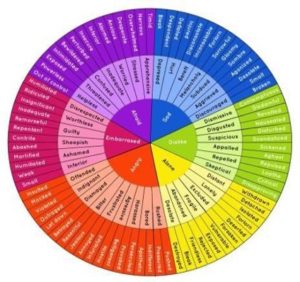Harnessing the Power of Emotional Granularity: Specifically Labeling Your Difficult Emotions.
Jarrett Green, Esq., M.A. Psychology, Lecturer in Law at USC Law School and UC Irvine School of Law
Rebecca Simon Green, Esq., Wellness Champion, and Lecturer in Law at USC Law School and UC Irvine School of Law


Jarrett Green, Esq., M.A., is a former biglaw litigator and Rebecca Simon Green, Esq., is a former full-time law professor, both of whom left their positions years ago to become well-being and peak performance consultants to the legal industry and corporate America. Jarrett and Rebecca are a husband-and-wife team that consult to and lead workshops at nearly half of the AmLaw 100 firms, as well as many Fortune 500 companies. They are the co-founders of the nationally-recognized USC School of Law “Mindfulness, Stress Management, and Peak Performance Program.” They blend science, humor, storytelling and easy-to-apply techniques to maximally impact audiences and catalyze personal transformation.
The article below is excerpted from the forthcoming book to be published by West Academic, Happiness and Peak Performance in the Law (working title), authored by Jarrett Green and Rebecca Simon Green. The excerpt is edited for brevity requirements of this publication.
If something causes you an unpleasant emotion like stress, sadness or anger, does the way you label that unpleasant emotion in your own mind affect its intensity and disruptiveness? Does your internal label of that emotion alter your resiliency and well-being in response? The science says it does.
What is Emotional Granularity?
Emotions can often be conceived of in general, broad terms, or in specific, narrow terms. “Emotional granularity” is the ability to put our feelings or emotions into words (internally or otherwise) with a high degree of specificity and precision. For example, low granularity would be identifying ourselves as feeling “bad” or “upset,” while high granularity would be identifying ourselves as “demoralized,” “lethargic,” “lonely,” “ashamed,” “anxious,” “furious,” “jealous,” “underappreciated,” “disrespected,” “self-conscious,” or “disempowered.”
The research shows that when we self-identify our unpleasant emotional state in precise and narrow terms, we improve our emotional intelligence, our overall well-being and resilience to the emotion at issue, and our consequent behavior in response to the emotion. Emotional granularity serves as a sort of buffer to the emotion, or an internal anchor that prevents the emotion from taking such a hold over us. In this way, the negative emotional reaction we have can be regulated and tempered based on our ability to specifically label it in our mind as the reaction is unfolding.
The term “emotional granularity” (aka “emotional differentiation”) was coined in 2001 by Dr. Lisa Feldman Barrett, an acclaimed neuroscientist and psychologist at Northeastern University and the Chief Science Officer for the Center for Law, Brain & Behavior at Harvard Medical School and Massachusetts General Hospital. To better understand how emotional granularity works, Dr. Barrett used the following analogy: Imagine an artist and a non-artist looking at two slightly different shades of blue.[i] The non-artist may see them both as “blue,” while the artist may see one as “azure” and the other as “royal.” The artist’s specific label positions her better to understand how each color was originally generated and how best to complement them. By labeling the color with specificity, the artist’s ability to process, comprehend and project implications from the color are superior.
Similarly, an individual who is able to label her emotions with specificity is better able to process, comprehend, and project implications from the emotion. By identifying the emotion (or color) with particularity, her relationship to the emotion (or color) fundamentally changes.
Are There Scientific Studies of Emotional Granularity?
Yes, numerous studies reveal the power of emotional granularity. An August 2021 study published in Frontiers of Psychology tracked participants’ emotional states from morning to evening for 21 straight days, as well their emotional granularity levels in response to stressful events during the day and their calmness levels and sleep quality each night.[ii] The study found that participants who practiced emotional granularity in response to stressors throughout the day were calmer and more resilient at evening, and slept better than participants who did not. As such, emotional granularity was determined to be a “protective factor that helps to explain why some individuals remain more resilient during times of stress than others.”
Another study found that individuals’ level of emotional granularity predicted their level of unhealthy rumination in response to stressors and depression symptoms for a six month period. The study found that higher emotional granularity is “associated with long-term psychological outcomes” and confirmed that it serves as an important “resilience factor” in navigating the stressors of life.[iii] Another study found that people who are better at differentiating their negative feelings are better at impulse control and 20% to 50% less likely to retaliate aggressively (i.e., verbal or physical assault) against someone who has hurt them.[iv] In another study, participants who were instructed to describe their emotions in more detail were more effective at resisting the biasing effects of emotion on judgments.[v]290 Another study found that individuals who engage in greater emotional granularity are less likely to drink excessively when they are stressed immediately prior to an upcoming drinking episode, consuming approximately 40% less alcohol than individuals who are lower in emotional granularity.[vi]
In a study assessing emotional granularity’s effects on anxiety, spider- fearing individuals trained to differentiate their emotions when observing a spider (e.g., “In front of me is an ugly spider and it is disgusting, nerve-racking, and yet intriguing”) experienced less anxiety and showed a greater willingness to approach spiders (i.e., reduced behavioral avoidance) compared with people who were given other strategies, such as cognitive reappraisal (e.g., “Sitting in front of me is a little spider, and it is safe”) or distraction (e.g., “Decide on the best time to floss teeth and make this a habit”).[vii] Moreover, at a follow-up assessment one week later, the spider-fearing individuals who were trained to differentiate their emotions experienced less sympathetic nervous system arousal (i.e., the fight-or-flight response) when confronted with spiders, compared with individuals in the other groups.
What About Brain Studies and Emotional Granularity?
Not only has emotional granularity been shown to induce greater resiliency and emotional regulation in response to challenging stimuli, but brain scans validate these findings. For example, neuroscientists from University of Wisconsin and University of North Carolina conducted live EEG brain scans on participants shown images designed to elicit an array of emotions, including fear, anger and disgust. [viii] Low granularity participants experienced more negative and more volatile brain wave amplitudes. The researchers observed, “this could explain why lowly granular individuals are ultimately worse at emotion regulation, because they have early reactivity to evocative stimuli but then do not engage resources to help make meaning of and subsequently regulate their affective responses.”
In another neuroscientific study, people who were adept at describing and differentiating their feelings showed less activity in the insula and anterior cingulate cortex when rejected by a stranger during a computer-simulated ball-toss game.[ix] As interpreted by a later study led by Dr. Barrett,[x] “[w]hile there might be many ways to interpret these brain findings, they are consistent with the view that . . . people with greater emotion-differentiation skills appear to show greater equanimity when confronted with the pain of rejection.”
UCLA neuroscientists and psychologists found that when study participants were shown images of an angry or fearful face, their amygdala (the fear and fight-or-flight center of the brain) activates.[xi] However, when participants were asked to attach a one-word label to the emotion they felt, their amygdala activation reduces considerably. So even a superficial form of emotional granularity — putting their emotion into a single word — materially altered their brain’s fight-or-flight response.
The science is so strong that when the world triggers us into unpleasant emotions, the simple act of putting those emotions into specific words in our own mind fundamentally affects how our brain responds, how overwhelming that emotion feels to us, and how prudent we are in our subsequent actions. As Dr.
Barrett and her colleagues have remarked: “these findings are impressive because emotion differentiation [granularity] is a simple, easily trainable skill that is frequently overlooked.”[xii]
How Can I Beef Up My Emotional Granularity?
We’d like to provide you with a very simple process for engaging in emotional granularity when you get triggered into a difficult emotion. First, label the emotion (or emotions) with the highest degree of specificity that you can. In the below figure, you will find a wheel of unpleasant emotions. Reviewing this can assist you in clarifying the nuanced distinctions between the various emotions.

From Happiness and Peak Performance in the Law (West Academic), authored by Jarrett Green and Rebecca Simon Green
Second, fill in the following skeletal sentence in your own head:
“I feel [specific emotion] because/that [specific reason].”
For example, “I feel demoralized because it seems that no matter how hard I study the material, I can’t seem to absorb it.” Or “I feel embarrassed and ashamed by the answers I gave when I was called on in class.” Or “I feel inadequate compared to some of my colleagues.” Or “I feel betrayed because my friend didn’t include me in the weekend get-together.”
Once you have identified the specific emotion and the specific reason you are feeling that emotion, move to the third and final step (the bonus step): rate the intensity of that emotion on a scale of 1-10, with ten being the most intense and most overwhelming, and one being the least intense and least overwhelming. (You can skip this bonus step if you’d like, as the first two steps constitute the level of emotional granularity encompassed by most of the research. But this third step is an easy way of adding one last notch of specificity.)
This simple 3-part practice can be a powerful tool to use in response to the emotional triggers that occur in law school and life. So when you feel a rush of challenging emotions, remember you have this tool in your back pocket. It only takes 5-10 seconds to perform, and the research reveals your brain, your overall well-being, and your subsequent behaviors will be benefitted. A handy cheat-sheet to print for this practice is at the end of this article.
The science tells us that labeling unpleasant emotions with increasing specificity not only will reduce disruption from those emotions, it will boost your resiliency and well-being. With this evidentiary backdrop and the 3-part practice, we are confident that anyone can increasingly harness the power of Emotional Granularity.
[i] https://news.northeastern.edu/2019/02/21/to-manage-your-anger-better-this-northeastern- professor-says-to-learn-the-difference-between-frustration-and-irritation/
[ii] Lischetzke T, Schemer L, Glombiewski JA, In-Albon T, Karbach J, Könen T. Negative Emotion Differentiation Attenuates the Within-Person Indirect Effect of Daily Stress on Nightly Sleep Quality Through Calmness. Front Psychol. 2021 Aug 11;12:684117. doi: 10.3389/fpsyg.2021.684117. PMID: 34456798; PMCID: PMC8385208.
[iii] Liu DY, Gilbert KE, Thompson RJ. Emotion differentiation moderates the effects of rumination on depression: A longitudinal study. Emotion. 2020 Oct;20(7):1234-1243. doi: 10.1037/emo0000627. Epub 2019 Jun 27. PMID: 31246044; PMCID: PMC6933110.
[iv] Pond, Jr, Richard & Kashdan, Todd & DeWall, C & Farmer, Antonina & Lambert, Nathaniel & Fincham, Frank. (2011). Emotion Differentiation Moderates Aggressive Tendencies in Angry People: A Daily Diary Analysis. Emotion (Washington, D.C.). 12. 326-37. 10.1037/a0025762.
[v] Cameron, C. D., Payne, B. K., & Doris, J. M. (2013). Morality in high definition: Emotion differentiation calibrates the influence of incidental disgust on moral judgments. Journal of Experimental Social Psychology, 49(4), 719–725. https://doi.org/10.1016/j.jesp.2013.02.014
[vi] Kashdan, T. B., Ferssizidis, P., Collins, R. L., & Muraven, M. (2010). Emotion differentiation as resilience against excessive alcohol use: An ecological momentary assessment in underage social drinkers. Psychological Science, 21, 1341–1347.
[vii] Kircanski, K., Lieberman, M. D., & Craske, M. G. (2012). Feelings into words: Contributions of language to exposure therapy. Psychological Science, 23, 1086–1091.
[viii] Lee, J. Y., Lindquist, K. A., & Nam, C. S. (2017). Emotional Granularity Effects on Event- Related Brain Potentials during Affective Picture Processing. Frontiers in human neuroscience, 11, 133. https://doi.org/10.3389/fnhum.2017.00133
[ix] Kashdan, T. B., Dewall, C. N., Masten, C. L., Pond, R. S., Jr, Powell, C., Combs, D., Schurtz, 90651. R., & Farmer, A. S. (2014). Who is most vulnerable to social rejection? The toxic combination of low self-esteem and lack of negative emotion differentiation on neural responses to rejection. PloS one, 9(3), e90651. https://doi.org/10.1371/journal.pone.0090651.
[x] Kashdan, T. B., Barrett, L. F., and McKnight, P. E. (2015). Unpacking emotion differentiation: transforming unpleasant experience by perceiving distinctions in negativity. Curr. Dir. Psychol. Sci. 24, 10–16. doi: 10.1177/0963721414550708
[xi] Lieberman MD, Eisenberger NI, Crockett MJ, Tom SM, Pfeifer JH, Way BM. Putting feelings into words: affect labeling disrupts amygdala activity in response to affective stimuli. Psychol Sci. 2007 May;18(5):421-8. doi: 10.1111/j.1467-9280.2007.01916.x. PMID: 17576282
[xii] Kashdan, T. B., Barrett, L. F., and McKnight, P. E. (2015). Unpacking emotion differentiation: transforming unpleasant experience by perceiving distinctions in negativity. Curr. Dir. Psychol. Sci. 24, 10–16. doi: 10.1177/0963721414550708
